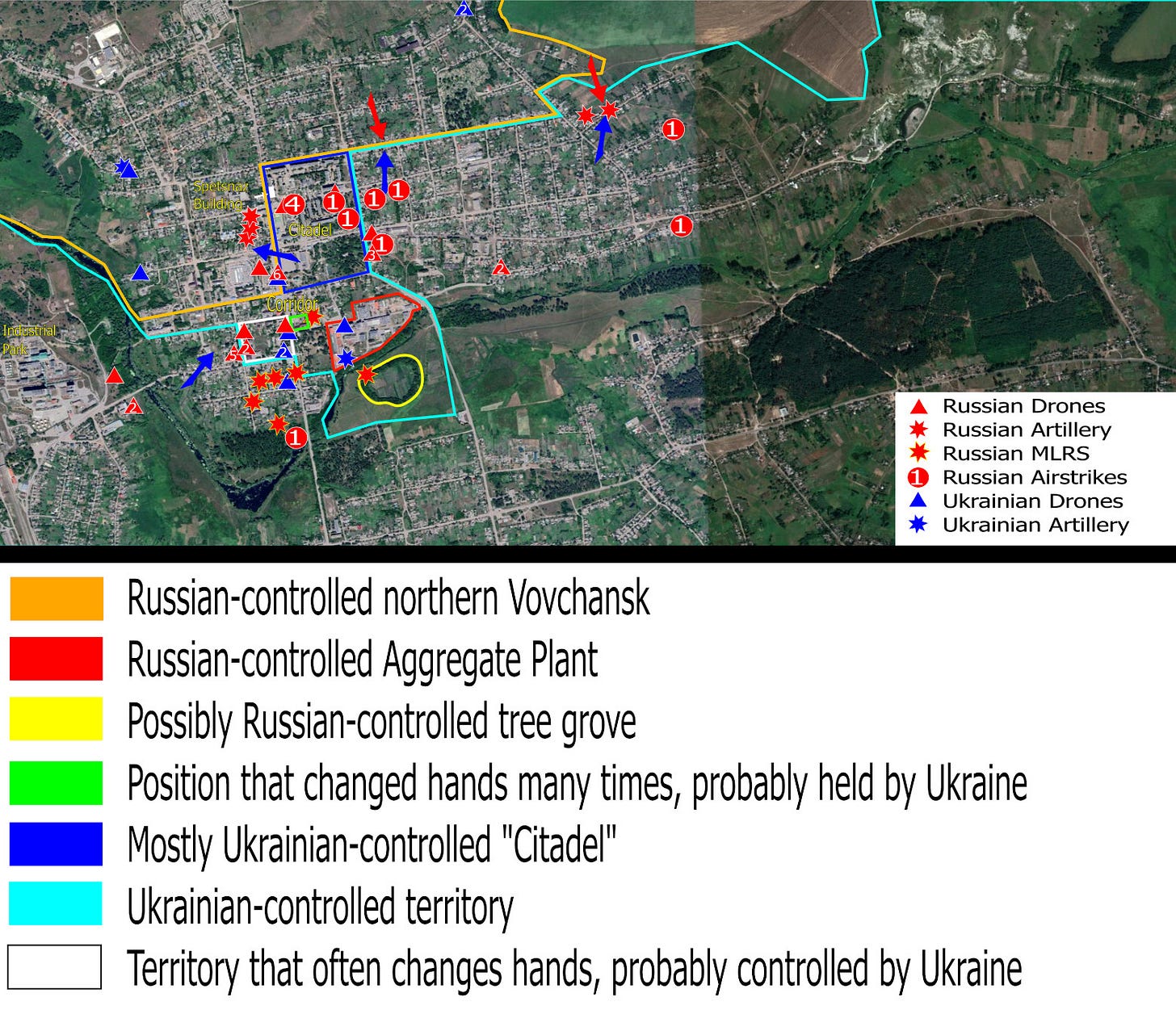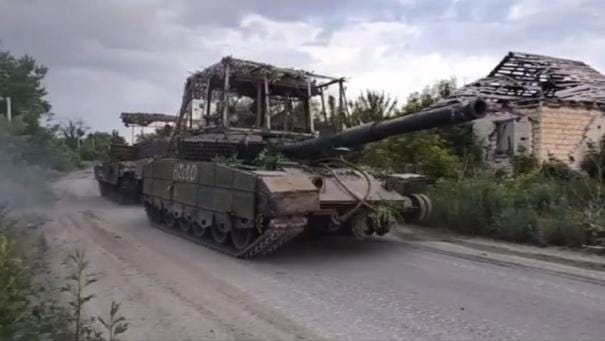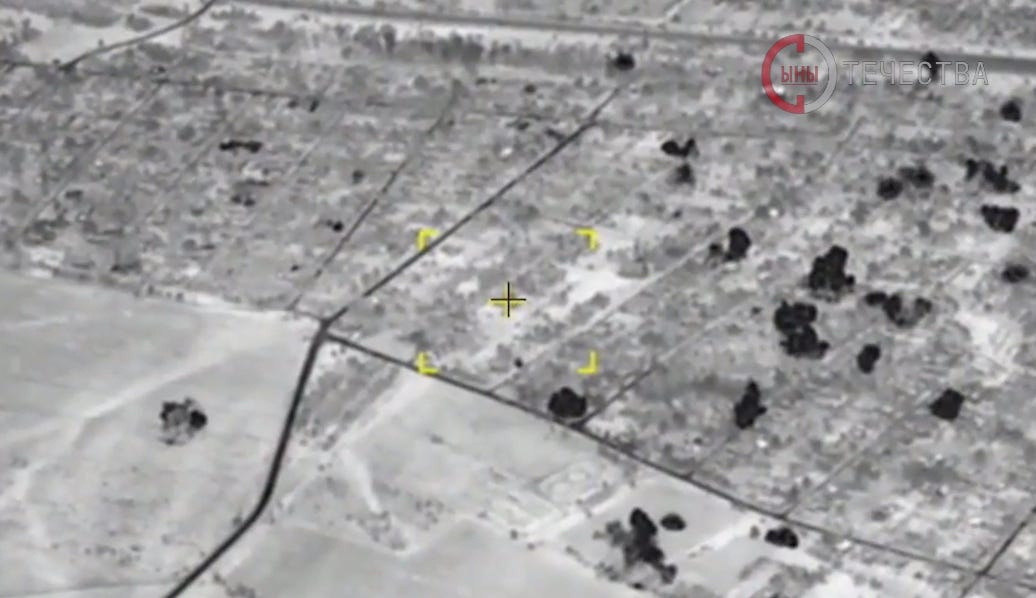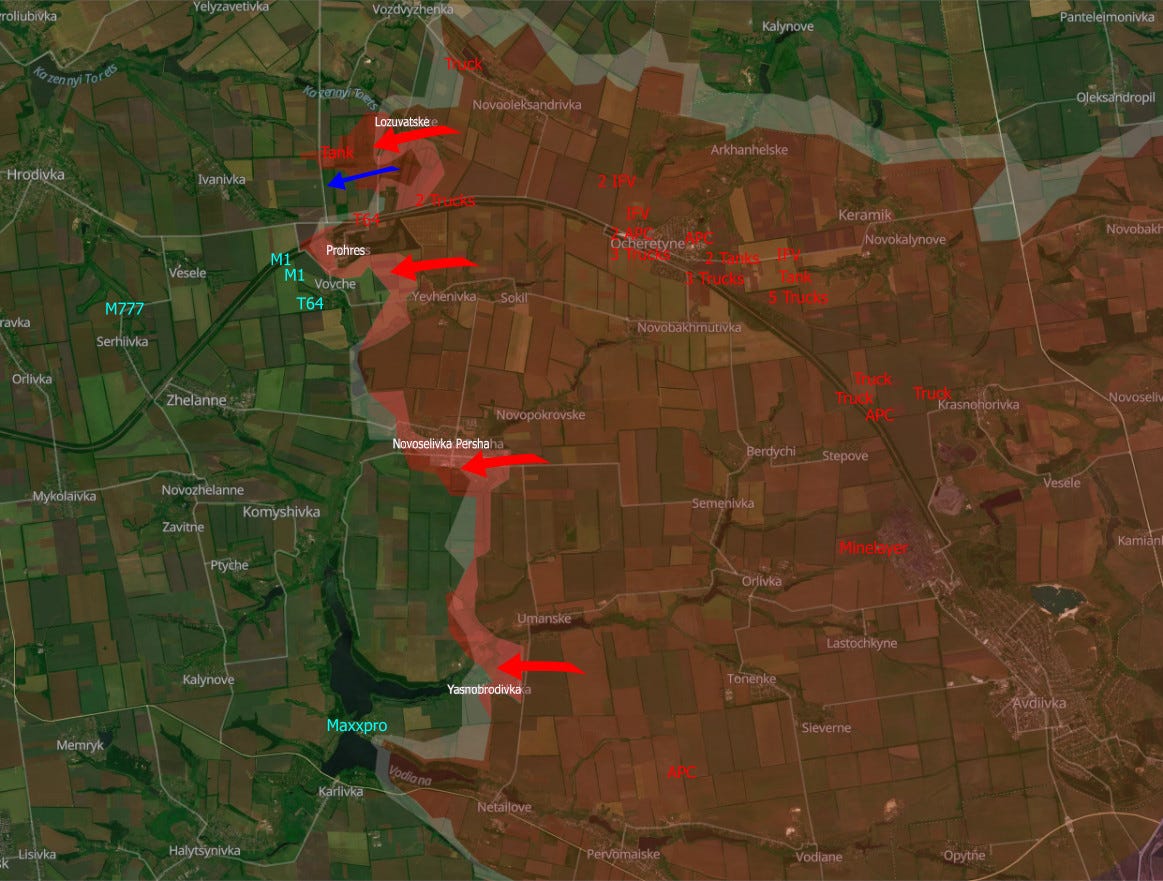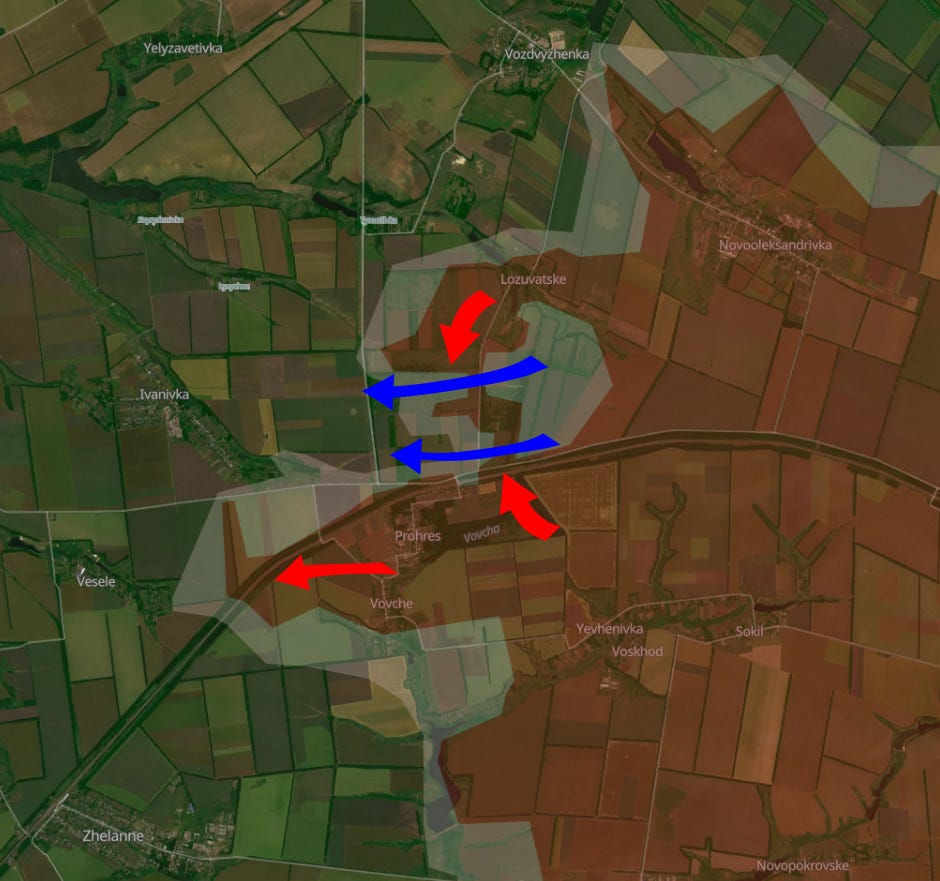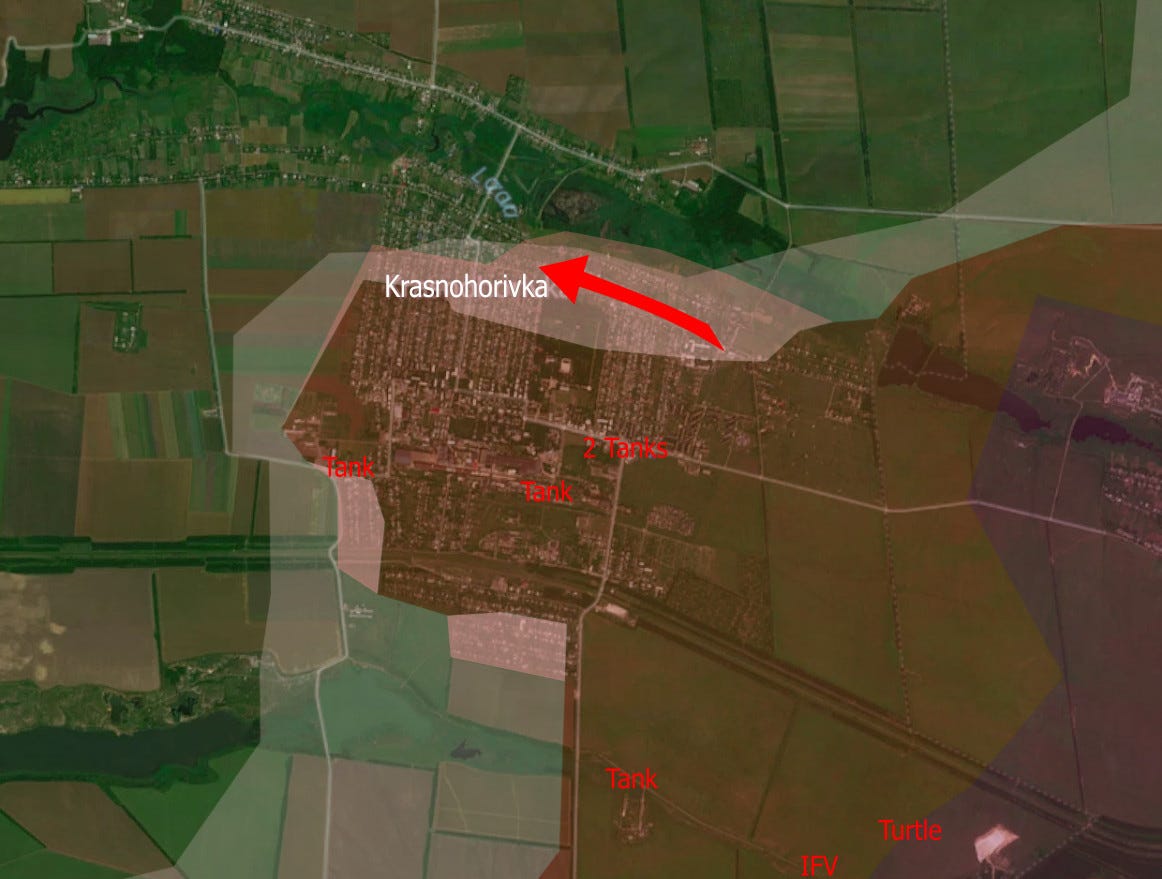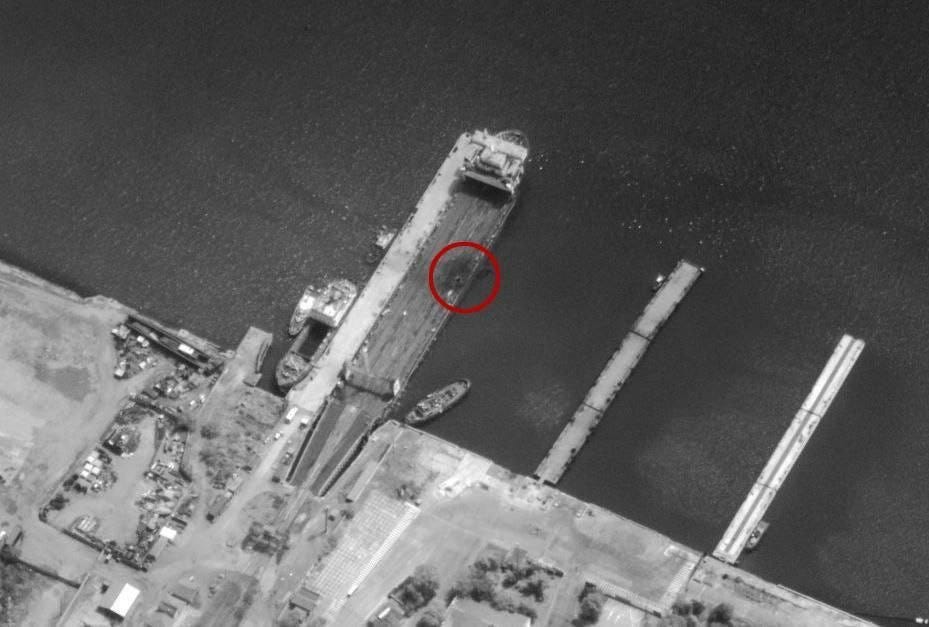Intro from Tom with a few added inputs from him throughout the report.
Hello everybody!
Because, between others, there are voices counting something like ‘average Russian advance tempo per week’, and we think it’s a bit different than that, this time, Donald has prepared something new:
Tracking the Fight
While combat is widespread throughout Ukraine, there are quiet sectors where territory hasn’t changed hands in many months, if ever, and there are sectors where either Russia or Ukraine is actively trying to advance. This map shows where each side is trying to advance and notes how many weeks they’ve been trying to advance in that sector. It also includes a rough approximation of the average number of meters they gained each week they were attacking.
When Ukraine’s 2023 Summer offensive started to wind down, Russia began to attack once again. They began with low level attacks in a couple of sectors in September, started an all-out attack in Avdiivka in October and started attacking in other sectors in November. From December until May, Ukraine was short on artillery ammo and that had an impact on their defences. In January, Russia advanced 2 km on a 7 km wide front towards Pischane and that started the slow unraveling of defences in that sector.
In February, Ukraine had stopped the Russian advances to the north and south of Avdiivka, but in the absence of artillery, Russian infantry began conducting mass assaults directly into the city. Ukraine had to rely almost solely on drones, which are very effective against individual targets but they are not as effective as artillery is on mass targets. It’s possible that Avidiivka might have fallen eventually even if there was plenty of ammo, but it would have happened months later and Russia would have paid an even higher price.
After the fall of the city, Ukraine slowly withdrew to Orlivka to create distance from the dominating terrain of the coke plant and take advantage of the small river west of Orlivka, but plans to establish a defensive line there fell apart when Russia broke through to Ocheretyne and heavy Russian assaults have been pushing them back at a rate of a kilometer a week ever since, and always leading the push in the northwest corner of the salient.
Russia gained 6400 meters pushing toward Terny from December to March but couldn’t make any more progress after that. At the end of June, Ukraine pushed them back 1900 meters in a week and that sector has been static since then, with only small Russian skirmishing.
Likewise, Russia attacked the Robotyne perimeter from October to June, the only sector they attacked in Zaporizhzhia. The combat here is characterized by large bombardments and small ground assaults. They gained about 2500 meters, but once they secured the symbolic center of that small village they weren’t able to advance for five weeks.
The advance from Bakhmut to Chasiv Yar was another large effort that cost Russia dearly, but to the south of the canal district, the defenses on the high ground overlooking Ivanivske suddenly collapsed. The 41st Brigade was pulled out of that sector and other units took over the defense of the compromised position, delaying its inevitable fall.
The 41st was moved to Toretsk, considered a quiet sector since the front line hadn’t changed since February 2023, and some of the sector hadn’t moved since 2015. Soon after being assigned to the sector, the Russians pushed them back 3.5 kilometers. Other units were brought in to stabilize the front.
Russia crossed the border into Kharkiv in May advancing 5 to 6.5 km in two weeks. Ukraine sent reinforcements and seized the initiative but their advance has been very slow.
Ukraine also conducted an assault in the Kreminna forest and managed to make a small amount of progress.
This map reflects over ten months of combat. Russian gains range from 400 meters in Bilohorivka to 20 km from Avdiivka. The rates of advance vary from 10 meters a week to a kilometer a week. This is not maneuver warfare, it is attrition warfare, and Russia lost so many armored vehicles in these ten months that they are now only used in small numbers outside of the sectors from Avdiivka to Vuhledar. In the southeast, Russia still uses and loses a lot of vehicles.
Russia is aware of their pending equipment shortages and increased their level of attacks when compared to before Ukraine’s 2023 offensive. The intent is to strain Ukraine’s army and they are having some success. Ukrainian soldiers say that their men are tired and their units are undermanned. At the same time, Zelensky says they have 14 brigades that cannot be deployed because they don’t have enough equipment. It is peculiar to stand up new units when existing units need replacements.
It’s a race to see which army will break first, but even with Ukraine’s self-inflicted wounds, they are in a much better position.
Kharkiv
Russia still controls the center of Hlyboke and is even trying to attack out of it. Its reinforcements and supplies follow the treelines that are attacked by Ukrainian drones and shells. Despite the combat, the front lines remained static.
Russia attacked in the center and east of Vovchansk but Ukraine pushed them out of any gains they made. In the west, Russian bombardment suggests that Ukraine is pushing out of the southern part of the ‘citadel’ and may have narrowed the ‘corridor’ from the south, as well. This area often changes hands so time will tell if Ukraine’s control is temporary or something more enduring. Not shown on the map was a Russian effort to cross the small river and attack the industrial park. Most of the Russian force was engaged north of the river and an MT-LB that was transporting troops was destroyed, but a small number of Russians made it across before they were destroyed.
Russian soldiers using anti-tank mines as satchel charges in Vovchansk. They are now using longer fuses, allowing the user to escape the blast zone. There are neighborhoods in the city that are very similar to open fields because the buildings have been leveled. This video of previous ATM satchel charges used in various sectors show how they level buildings.
Ukraine sent a ground drone with 200 kg of explosives to detonate against the side of one of the buildings in the aggregate plant. The drone made it into the east side of the compound when it blew up. It wasn’t directly adjacent to a building so it was similar to a near miss from an aerial bomb.
Soldier of the 82nd Brigade discuss their experiences at Vovchansk.
Western Luhansk
The battle lines remained where they were, for the most part, and Russia widened their control over Pishchane. They planted a flag at the edge of their control in Pishchane and then ran for cover. What’s interesting about the second video in the same post is that it took place 17 km to the south on a piece of terrain that was over a kilometer from the front…and in a section of the front line that hasn’t moved for months.
The bridge across the Oskil river at Kupiansk-Vuzlovyi was knocked out a while ago so the Ukrainians built a pontoon bridge that was destroyed by a Russian airstrike.
The 63rd Brigade sends a ground drone to attack a Russian trench. They don’t have to be kamikaze drones, they can drop off the payload and detonate it remotely.
Bilohorivka
Russia has been attacking from the east since May 2022. They briefly captured Bilohorivka before Ukraine liberated in September of the same year and Russia has made little progress since then. For the last three months they’ve been attacking from the south and have slowly been advancing. That was true again last week.
Three Russian bombs land in a northern suburb of Siversk.
A treeline is bombed by Russians not far from Spirne.
Bakhmut
Russia is conducting small probing actions along selected spots along the canal but also on the flanks in the hopes of widening the front. There were no large assaults but the daily bombardments continued to burn the city down.
On a different day than the still image above, more of Chasiv Yar burns in this video. Unlike the concrete buildings of the canal district, most of the buildings in Chasiv Yar will just burn down.
Toretsk
Russia is pressing hard in front of Toretsk but has not gained any territory. At Niu York, Russia has a four kilometer long and two kilometer wide penetration that is potentially vulnerable but Ukraine hasn’t been able to cut it off and Russia grabbed three more treelines that are between 400 and 1000 meters long. Inside Niu York itself, Russia is holding on to a block of apartment buildings and fighting off strong Ukrainian attacks.
After posting a video on July 20th of a jet they shot down, the 110th Brigade posted another video on July 23rd. The pilot was rescued by Russian ground forces 8 km south of Niu York.
Ukrainian troops clear an apartment building in Pivnichne. They knew Russian soldiers had been in that block but they weren’t sure which of the buildings were occupied. They use suppressive fire though walls and doors before entering, without any idea if Russians will be on the other side. A key aspect of clearing a building is to secure the stairways so the enemy can’t move between the floors and re-enter an area that has already been cleared.
The initial collapse in the sector occurred when the 41st Brigade was assigned to the quiet sector. A platoon leader in the brigade claimed that they are a Territorial Defense unit with assault rifles and mortars and not a lot of other equipment, that they are short of personnel and most of their personnel are older men. His battalion deputy commander agreed, saying that these shortages are ignored and the personnel are worn out by years of combat.

Pokrovsk-Avdiivka
Russia finally moved into Yasnobrodivka and completed their occupation of Novoselivka Persha. They also pushed out of Prohres by as much as 3500 meters. And Ukraine continued to detect and interdict vehicles assembling in the coke plant and moving towards the front, as evidenced by the trail of wrecks. A Russian reporter said that a year ago, Russians would dismount a kilometer from the front to attack Robotyne. Now they have to dismount 8-10 km from the front. Near Avdiivka, Russian vehicles are being interdicted up to 20 km from the front line.
At Lozuvatske, though, Ukrainian front line outposts of the 31st brigade were cut off as deep penetrations through Lozuvatse and Prohres allowed Russia to move behind them. If communication between all the units are working well, the front line units could be told to pull back when their flanks were threatened. That didn’t happen. In fact, there is a report that when they were surrounded, the brigade commander didn’t give the order from them to break out and didn’t take any measures to support their breakout. The battalion commanders confronted him and, with the help of the 47th Brigade, managed to break their troops out of the encirclement.
Starting with Ocheretyne, Russia continues to have success against the Ukrainian units in the northwest corner of the salient. Every Russian success in the northwest unravels the Ukrainian defenses to the south and threatens the main supply line from Pokrovsk, which is 19 km west of the front lines near Prohres.
Marinka
Russia is slowly and inevitably advancing through Krasnohorivka, but they must still transport infantry into the city and their vehicles still suffer damage.
The Russians assembled a force of 57 armored vehicles, 12 motorcycles and 200 infantry. Ukraine detected the large force and started to engage them at least 7 km behind the front lines with drones and artillery, and eventually mines and ATGMs. At least 6 tanks, 7 IFV/APCs and all 12 motorcycles were destroyed and 40 personnel were killed and 37 wounded. When the first wave was destroyed, the rest of the force retreated.
That was the largest attack in weeks but there were other large attacks, too. From Marinka to Vodiane, Russia suffered 55 vehicles damaged or destroyed. Russian infantry accompanied this attack, as well, and when they lost their transport they were hunted by drones for hours and suffered a lot of killed and wounded. In past wars, there are usually three wounded for every soldier that is killed. When Russian infantry lose their transports and are exposed in the open, the ratio is closer to only one wounded for each soldier killed.
Ukrainian artillery engages Russian assault groups as they approach Kostiantynivka. If you look at the map you’ll see that 21 vehicles were eventually damaged or destroyed there.
A couple weeks ago, a Ukrainian tank was hit by a drone and set on fire. The tank turned around and while it was moving towards friendly lines, the commander exited the turret and put out the fire with an extinguisher.
Somewhere in Ukraine

Crimea
In 2018, Russia had four ferries in the Black Sea that could transport trains and rail cars by moving directly from the tracks to the ferry by a method called Roll On, Roll Off (RORO). In May of that year, one of those ferries, Annenkov, collided with a pier at Port Kavkaz but was found to be unharmed. Less than two months later, cargo from a rail car fell onto the deck, creasing the hull and tearing ten holes that caused the engine room to flood. After repairs, it continued in service but in 2020, leaks forced it to be beached at Aliaga on Turkey’s Mediterranean coast.
On October 8, 2022, a truck that was carrying explosives planted by Ukraine blew up while on the bridge. On the adjacent railway bridge, a train carrying fuel just happened to be traveling by and the fuel cars burned for hours after the blast. The heat from those fires permanently weakened the rail bridge even after it was repaired. In its weakened state, the bridge regularly supported passenger train traffic but the heavy loads of fuel cars rarely crossed the bridge anymore. Instead, the Russians would move the fuel cars to Port Kavkaz, load them on to the three remaining RORO train ferries and offload them at another port located 4.5 km across the Kerch Strait.
With Russian military vehicle traffic mostly using roads through Zaporizhzhia, and Russian rail traffic mostly using the rail ferries, the military importance of the Kerch bridge was reduced.
On 30 May 2024, the rail ferries Avangard and Conro Trader were both hit by ATACMS and damaged. The oil tanks at Port Kavkaz were also attacked and four tanks burned. Since its ability to transport oil across the Kerch strait was reduced by 66%, the Russians sent a train with oil cars over the Kerch bridge on June 9th. It was the first time they did that since February. The Kerch bridge became a little more important.
This left the Slavyanin as the only rail ferry left in the Black Sea. It was carrying cargo from Bulgaria to Turkey on November 8, 2023, when it collided with another ship, damaging its railing and its ballast tanks, which took on water. On July 23rd, it was hit by a aerial drone and damaged.

There aren’t any published estimates of how long it will take to repair the ferries, but until they are repaired, Russia lost one of its routes to deliver oil to Turkey, and it must deliver oil by rail through Zaporizhzhia, within range of HIMARS/MLRS, or it must use the Kerch bridge.
NATO regularly sends manned and unmanned reconnaissance aircraft to the Black Sea. A month ago they sent a plane from the UK to the international waters of the Black Sea in order to locate the source of Russian electronic emissions and determine the type of device that sent the signals. Last week they sent another plane from the UK with two fighter escorts. NATO sent other aircraft to the Black Sea to provide more traffic for Russian radar operators. When the reconnaissance plane and its escorts approached Crimea, they turned off their transponders for 90 minutes as they likely came closer to locate Russian air defenses. The Russians scrambled an Su-27 to intercept but the reconnaissance team ignored it and completed its mission. The Russians know that NATO is passing on intelligence to Ukraine, saying that within two days after a reconnaissance flyby, Ukraine launches an attack against targets that have been located.
At the same time, Atesh, a Ukrainian resistance group in the occupied lands, say Russia does not have enough air defenses to protect the entire Crimean peninsula so they are focusing on the defense of the Kerch bridge.
Russia
After the Engels airbase near Saratov was attacked in March, Russia moved its bombers to Olenya air base on the Kola peninsula. That increased the distance from Ukraine from 700 km to 1800 km, but Ukraine struck that air base with drones and reportedly hit a Tu-22M bomber. Dyagilevo air base, where bombers are stationed 160 km southeast of Moscow, and Engels air base were also hit. The results were unclear but smoke was reported at Dyagilevo. Polevava oil depot consists of ten tanks. Two were destroyed in February, and three more were destroyed last week. An Mi-8 helicopter burned at Kryazh airfield (900 km from Ukraine) on July 24, and on July 21, explosions were heard at a helicopter plant outside Moscow. An analyst confirmed the location of the fire and Ukraine reported that both an Mi-28 helicopter and a Ka-226 helicopter were reported destroyed.
An Su-34 went down of its own accord near Volgograd. The crew survived.
Three days ago, also one of Mi-28 attack helicopters, crashed while involved in UAV-hunting operations inside the Russian Federation, about 20km behind the border to Ukraine. The type is meanwhile notorious for its poor mechanical reliability, and susceptibility of its avionics to bad weather: thus, the VKS is keeping it away from the frontlines (or if deploying it there, then always herded by Ka-52s), and using its remaining Mi-28s to hunt Ukrainian UAVs.
The Tuapse refinery was attacked once again with drones. Russia said it shot down 75 drones, mostly in the Rostov and Krasnodar regions and over the Black and Azov seas. In the article, there is a video showing a flying drone impacting the refinery.
The attack on Russia’s energy grid continues as substations in Belgorod are hit.
The Russian army has mostly recruited the poor and minorities to sustain its force while residents from St. Petersburg and Moscow have been underrepresented. Russia is now offering $22,000 to Moscow residents if they join. If they are injured, they will receive $5,690-$11,390, depending on the type of injury. Their families will receive $34,150 if they are killed.
A Tu-160M that Putin flew on in February crashed in April due to maintenance issues.
An Su-34 was hit by a SAM but was able to return to base and land.
The debris of three Russian drones ended up on Romanian soil.
Ukraine
In occupied Mariupol, a Russian report said that a couple offered Russian soldiers watermelon to thank them for their service. It was laced with arsenic. 12 died and 4 ended up in the hospital. Russians report that since the beginning of May, 7 other soldiers in Mariupol died from poison, gunshot and stab wounds.
Last April, 4.2 million Ukrainian refugees were given another year’s extension to receive service from their host country and to work there, as well. Poland, Germany and the Czech Republic are where most of the refugees are located. In Poland, between 225-350,000 refugees are working, contributing an estimated 0.7-1.1% to Poland’s GDP. Six million Ukrainian refugees are located in Europe and 500,000 are located elsewhere. 10% of the refugees wish to settle outside Ukraine but 66% want to return home. Ukraine has a 35% energy deficit which causes both scheduled and unscheduled power outages. The aerial bombardments across the country also contribute to concerns about living in a war zone.
Diplomacy
The EU has €210 billion in frozen Russian assets that earn about €3 billion a year in interest. The first €1.5 billion of that money has been transferred into a European fund. 90% of that money will be used to reimburse countries that sent arms or ammo to Ukraine. 10% will be used to build Ukraine’s defense industry or general reconstruction in case member nations, such as Hungary and Slovakia, object to the funds being used to send weapons and ammo to Ukraine.
After NATO held a meeting with Japanese and South Korean participation, Chinese troops held a 11 day joint military exercise in Belarus. They agreed to "oppose external interference and resist unilateral bullying”, saying that the alliance "keeps reaching beyond its boundary, expanding its mandate, stoking confrontation and acting like a bully on the world stage. … NATO should not use China to justify its insertion into the Asia-Pacific and attempt to disrupt regional dynamics." The Chinese leader Xi also visited Serbia and Hungary as their cooperation deepens.
At times, Russian missiles have briefly crossed Polish territory. In 2022, two Poles were killed by a Ukrainian missile engaging a Russian missile near the border. Poland wants to engage the missiles before they enter Poland to protect its citizens, they say.
In October, 2022, the German railroads were sabotaged in two places at the same time hundreds of kilometers away. On the opening day of the Olympics, the French rail systems was sabotaged simultaneously in three locations and a fourth attempt was defeated.
After saying Ukraine can use Storm Shadow missiles in Russia, and then clarifying that they couldn’t, the UK is once again affirming that Ukraine can use Storm Shadow missiles in Russia, a statement they have yet to rescind.

Mali had coups in 2012, 2020 and 2021. The UN, EU and African Union condemned the coup, the regime asked the UN peacekeepers to leave and Wagner mercenaries arrived in January, 2022 to support the regime. Tuareg rebels in the north ambushed a convoy, killing and capturing government and Wagner troops. One of the Russians killed was reportedly a Russian commander responsible for Bakhmut and Soledar offensives, a battle that was dominated by Wagner participation. After the rebels offered to send the Russian prisoners to Ukraine, Ukrainian private citizens responded with gratitude and one offered to send them drones.
In May, the leader of the Georgian Dream Party accused the US of “funding violence” and supporting “revolutionary processes” after the protests against the Kremlin-inspired foreign agent bill was passed. The party often accuses the US of wanting to open a second front against Russia to support Ukraine. As a result of these accusations, the US is conducting a full review of its bilateral relationship with Georgia and will not hold a joint military exercise with Georgia. The EU is freezing $32 million in military aid, halting Georgia’s accession to the EU and will be redirecting that money to the country’s civil society and media. Georgia’s foreign minister calls the decision "incomprehensible". Georgia had been one of the most pro-western Soviet successor states.
Equipment

Russia started using inexpensive drones ($10k or less) in their strategic bombing campaign. They can fly up to 1,000 meters in altitude, out of machine gun range, and are used as decoys and to discover the dispositions of Ukrainian air defenses.
Boeing and Ukraine will now build drones together. Boeing has produced high-end drones with a high price tag for decades. It will be interesting to see what they develop on Ukraine’s budget and the impact it will have on the US military.
A 122 mm D30 howitzer, complete with anti-drone grill and explosive reactive armor.
The equipment US sent Ukraine was overvalued by $2 billion. This is not the first time this has happened. By the US’s own accounting rules, older equipment that is donated is assessed at a lower dollar value. This means the US can send an additional $2 billion worth of equipment and ammo.
A brief look inside a Bradley fighting vehicle.
More aerial combat between drones.






